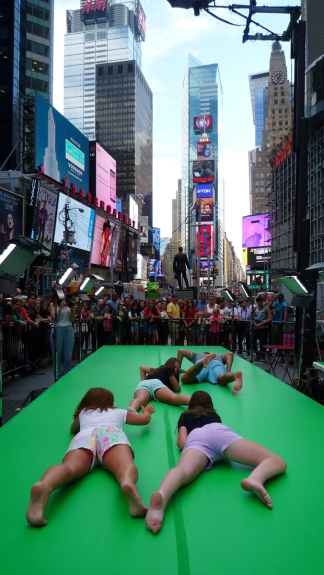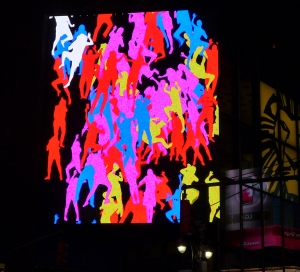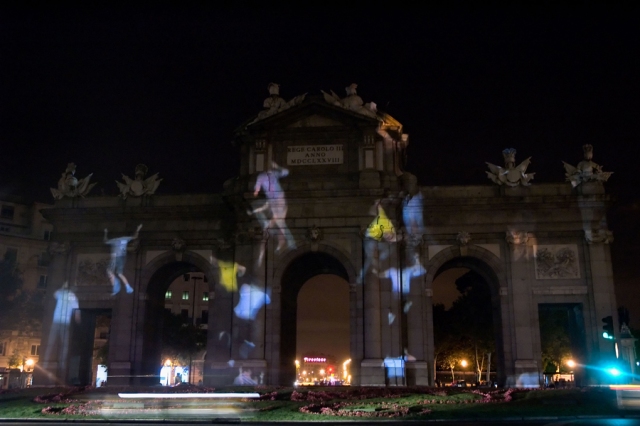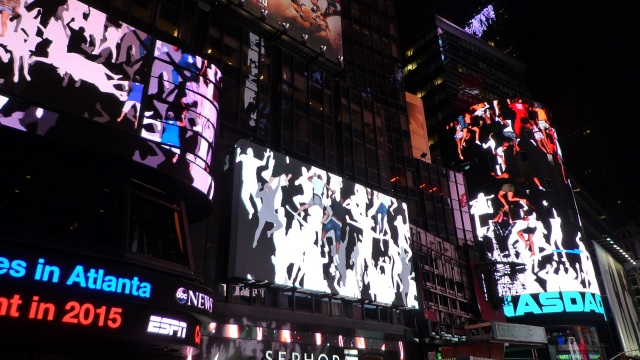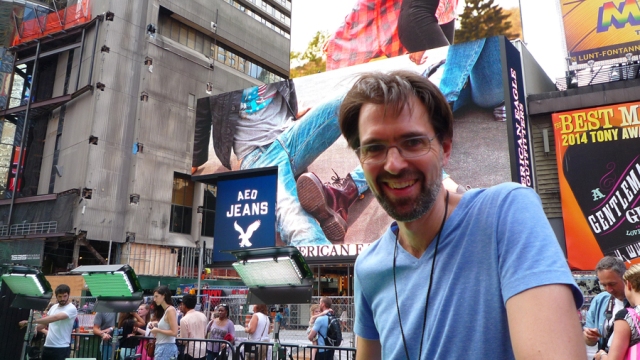
Artist Daniel Canogar during the filming of Storming Times Square, July 24, 2014. Photo © Kathleen MacQueen.
Daniel Canogar
Storming Times Square, 2014
11:57 pm – 12:00 am, daily
In our everyday existence, we face any number of challenges from the banal to the life threatening and – in dire circumstances of upheaval – to the truly horrific. Where do we find strength? What metaphors signify for us the power to overcome adversity? We search for answers within interpersonal relationships but also outside ourselves in literature, philosophy, religion, community, and art.
Such an investigation can take years but, occasionally, a timely event suffices. 1200 individuals stumbled upon inspiration by chance, last month in New York City, when artist Daniel Canogar introduced his project: Storming Times Square. For four days he filmed passersby for his multi-channel animation now being displayed nightly, featuring participants climbing up the Times Square LED billboards as though they were storming the citadel just before midnight.
Shifting Connections spoke with Canogar in 2011 during his participation in New York’s Into the Light public art event in Greenpoint, Brooklyn. We spoke then about his public interventions being rooted in a sense of history, an awareness of current migratory struggles, and the urgency to reclaim urban topography for the public. He discussed previous projections including Asalto (2009) created for Segovia’s Alcazar castle, and Clandestinos (Clandestine) (2006) for Madrid, Rome, and Rio de Janeiro. The idea was conceived after the artist had viewed media reports of hundreds of refugees climbing the fences that separated Morocco from Ceuta and Melilla, Spanish territories in Northern Africa. As Canogar noted then, “They were tearing up their own bodies on the barbed wire, trying to jump the fence that separated them from Spanish territory, and beyond that, Europe. Most of us are so unaware of the measures that immigrants take to cross borders.”
In our conversation today, he describes his understanding of the motivation of such a desperate struggle: in a sense, we are all intruders in contemporary society, trying to move beyond limitations to re-establish our potential for securing wellbeing and success. What struck me most when I visited the making of Storming this July was the range of participation – each contributor an Every(wo)man – the selection process completely open to the full range of individuals wandering through this quintessential center of urban capitalism.
This conversation for “In sight/In mind,” via Skype between New York and Madrid, brings us up-to-date on the artist’s engagement with the public and with urban space:
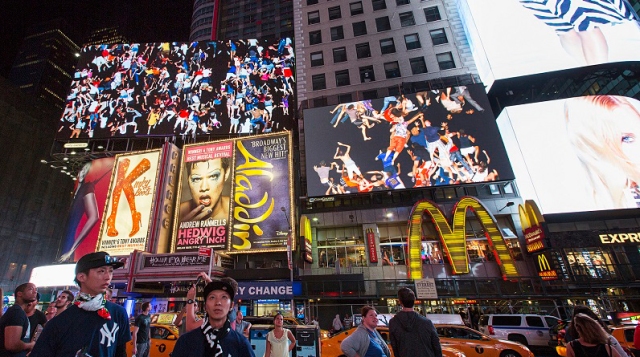
Midnight Moment: Daniel Canogar, Storming Times Square, 2014. Photograph by Ka-Man Tse for @TSqArts.
Kathleen MacQueen: This is your largest public event to date – 1200 participants in four days! It also takes place in one of the world’s best-known icons of public space: Times Square. This is at once a consumer space and a technological space. The billboards are used 24/7 for advertising and yet you endeavor to exchange that message of consumption for another kind of desire. What is your vision, first, for the participating public and, second, for the viewing public?
Daniel Canogar: With Storming Times Square, I’m very interested in making the divide between viewers and participants – so strong in the mediated experience of film and television – crumble. This goes back to earlier performing arts when the frontier was more elastic and the divide between viewers and participants was purposely crossed, whether from heckling on the part of the audience to performers moving off the stage and circulating among the audience. I’m interested in this kind of hybrid public space that is both a place to view and to act. So in my work, even if there’s a temporal division between shooting and displaying the work, there is already an audience for the participation…those who watch those who perform or those who watch first and then decide to perform.
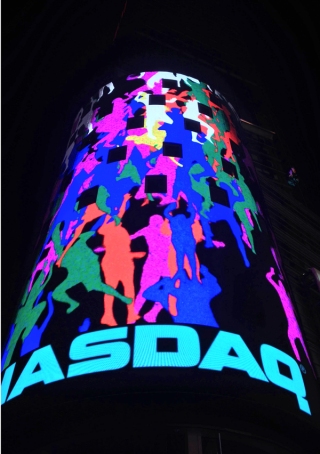
Midnight Moment: Daniel Canogar, Storming Times Square, 2014. Photograph by Chris Romero for bitforms Gallery.
This breaking down of barriers is interesting because 1) it complicates the idea of spectacle and 2) it opens up a conversation about the public square where you go to look and be looked at, where you go to gossip, where you go to buy and to promenade. This is still very alive in squares in Europe but in New York you see a linear trajectory from home to work and back again. Union Square, Washington Square, and Time Square are exceptions to this linear trajectory. But in Times Square the people who go simply to hang out are primarily visitors. So, yes, a space of technology and consumption but also public space…and how the public acts in that milieu.
KMQ: On the one hand, you create an opportunity for many yet you engage individually with each participant. That’s got to be a lot: 1200 in four days. At the same time, given the numbers, the time span for participation is brief. Your intervention has the dynamics of an adrenalin rush; what can you hope to accomplish in the long term?
DC: That’s a tough one! I can only speak for myself and not the participating public but I was the first one to crawl along that green screen to inaugurate the piece. My hope is that we can find ways to leave a mark in the public realm, a space that is being eroded by privatization. A healthy city needs these spaces to create a connection between citizens and a sense of identity so I’d like to increase opportunities to intervene and participate in our cities, as opposed to being passively spoon-fed an urban reality that we have no say in. Storming Times Square makes an effort to allow for collective presence in cities over whose shape we have so little control.
KMQ: A sense of impotence is far too often the norm of contemporary social experience. How does a creative action of this kind refer to or relate to the notion of “participatory democracy”?
DC: Without wanting to present this project as an Occupy-Wall-Street intervention, I can say that participation is an important aspect of this work. However, I am cautious about framing my work in purely political terms because readings of the work have varied widely. Returning to the ideas in Roland Barthe’s The Death of the Author, an artwork happens again and again in a new way every time it is “read” by a viewer.
For example, there is the adrenalin charge of being in the “hot spot” in the middle of Times Square. People were laughing, dragging themselves along the ground, moving and placing their bodies in a manner and space that isn’t typical. So, yes, participation in a democratic process is a central notion but not the only notion of Storming Times Square. Just taking people out of the norm and having some fun…
KMQ: …being playful! What’s potentially embarrassing or even humiliating ends up being uplifting. We’re no longer within our realm of composure but, from my participating experience, it requires something of an alter ego to perform for that moment, breaking the continuity of expected behavior.
DC: I got one very negative reaction: an older man asked me, “Why are you doing that to people? Making them grovel and crawl along the floor?” I was taken aback by this interpretation that seemed almost mythical or biblical, likening the human to the snake as a mark of degradation. For me, the crawling gesture was about becoming reptilian or animalistic but, more importantly, going back to childhood to our first steps as infants and how we all have crawled. It’s really our first adventure!
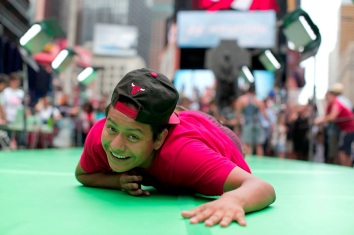
Midnight Moment: Daniel Canogar, Storming Times Square, 2014. Photograph by Clint Spaulding for @TSqArts
KMQ: Our first moment of triumph!
DC: It’s a huge effort but the exhilaration of daring to move away from the security of our mother and explore space is one of our first sensor/motor readings of the environment. I also become aware of each participant’s vulnerabilities when I observe them crawl along the floor; this touches me every time.
KMQ: This is how we demonstrate that we can be more than the roles that are prescribed for us, that we can extend beyond expectation. But as far as the viewing public is concerned, it is almost as if you first address what Jean-Luc Nancy considers the capacity to listen: “Pay attention! Listen to me!” Then additionally, you are making a statement about the role of the collective in the public sphere: when we participate in this event, we do so individually or in small groups of 2, 3, or 4, then you assemble these takes together to create a collective mass of reptilian humanity. What’s happening in that shift from the individual to the collective?
DC: A lot of my work has to do with collective experience, with groups of people – trapped by technology, floating in water, pulled by gravity, lost in space – being affected by forces beyond their control. This is a constant personal struggle between individuality and collectivity. I feel overwhelmed by the crowd – the masses of people who move through heavily populated city centers – perhaps it goes back to the theories of Elias Canetti and Siegfried Kracauer on the ornamentation or instrumentation of the masses as a preamble to the rise of fascism in Europe.
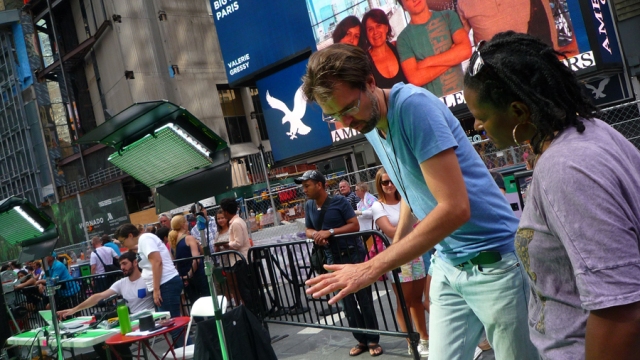
Artist Daniel Canogar during the filming of Storming Times Square, July 24, 2014. Photo © Kathleen MacQueen.
As you say, I spoke to almost all participants – had an exchange of words and observed them – I see them as collaborators and got a small snapshot impression of each one. Even after the editing process, as the players scale the walls of Times Square, I recognize individuals, not only those I know well but many who I remember from those four days in July. I’ve never had to explain my work before to so many strangers! “What are you doing? What is this for?” This event has profoundly altered my experience of the crowd, with which I feel a lot more at ease. I now feel as if I could talk to anyone about anything.
KMQ: The way you speak of the collective appears to be a personal struggle with the unknown, perhaps even the subconscious. Rather than internalizing the external world, it is almost as if you externalize your internal reality. But rather than the crowd functioning as automatons of fascism, I see your crowd as evidence of enduring potential. The sense of “what can be”…yes, much of your work deals with entrapment but since Clandestinos and Asalto there’s too much agency for it to be any longer about entrapment.
DC: Yes, I like that word “agency” and since there is an effort to crawl along the green screen space – not for the four year olds but for anyone else – this effort translates on the screen as a struggle to climb. One individual viewing the piece suggested that New York City is known as a place where you want to succeed, to reach the top, and if you make it here, you can make it anywhere. In this reading, gesture and motion becomes a metaphor for the collective helping the individual to reach the top. This makes a lot of sense in Times Square.
But the title itself refers to revolutionary upheavals: the storming of the Winter Palace or the storming of the Bastille. My first public projection was here in Madrid, on the Puerta de Acalá, which was a gateway or threshold where passage into and out of the city was once controlled like our borders today. While I was shaping my ideas for this project, the media was full of stories of sub-Saharan Africans trying to cross into Spanish territory in northern Africa. Individually these refugees would not have a chance but by overwhelming the authorities, which had orders not to harm them, they could cross the border. I could identify with this action: we are all intruders in a kind of way, climbing fences, trying to improve our lives. It was this collective effort that made a difference and that increased the individual’s chance for success.
KMQ: This sense of intrusion can be viewed simply as an effort to move beyond limitations and broaden our potential for success. Perhaps work like this can in some way reduce our horror of the stranger. This is what life’s struggle is: to say – “No, I’m more than these limited perimeters and expectations and I’m trying to get beyond how the outside world sees me and boxes me in!”
Times Square is an iconic place – but hardly a political arena – how do your visual strategies function in relation to the advertising image?
DC: These are things that are discovered along the way, in the doing. Certainly my videos are layered but I believe they are also very direct and not slick in any way. Both the advertisers’ images and mine show bodies but they are very different bodies. The contrast between the advertising ideal and my direct images of a wide array of human forms – even the clash between the advertising images and the real bodies performing the action in July – is food for thought.
The entire participation was incredibly international – I can’t imagine a nation that was not represented – it became a global project. That was an interesting surprise. I also had a full range of ages from toddlers to individuals in their 70s and 80s. This was phenomenal.
KMQ: One of your visual strategies is to shift from realism to abstraction. What’s the significance of this?
DC: This came about in Greenpoint, New York, when the live-video shoot was canceled because of rain. We were obliged to use pre-recorded footage and devoted our time to playing with the projection, changing figures into silhouettes and shifting their colors. Was this crossing a line? Asking people to participate and then manipulating their image? At first this worried me but I’ve come to see the shift from an emphasis on the individual to a more abstract rendition as a move towards the collective. The abstract image becomes a collective organism – an entity in itself. What survives of the individual as he or she becomes subsumed by the collective? Also, ironically, narrative is enhanced by abstraction rather than reduced. I like this.
KMQ: Does this pull us into a bigger story, a larger sphere, and a public realm?
DC: These are all important questions. New York City, especially, is a tough nut-to-crack in that sense: it keeps pushing its citizens out of the city because they can’t afford to live in this place they call “home” – no longer being able to sustain themselves. It is then really relevant to be able metaphorically – and actually – to project ourselves, making ourselves visible, within the cities we live in…
KMQ: Yes, absolutely! And to retain a sense of individual presence within the collective experience…
DC: Yes.
Storming Times Square is part of “Midnight Moment,” the largest coordinated effort in Times Square to display synchronized, creative content on electronic billboards throughout Times Square. “Midnight Moment” is organized and supported by the Times Square Advertising Coalition (TSAC) in partnership with Times Square Arts, with additional partners of participating sign holders and artists.

